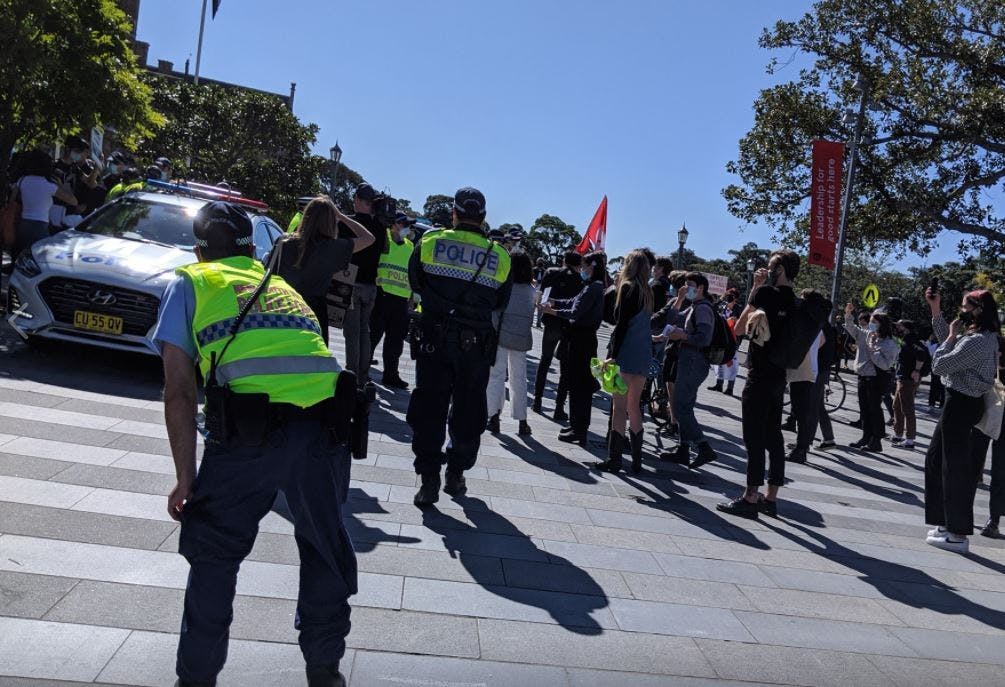NSW police use health crisis to attack democratic rights

Sydney University was the site of a serious police crackdown on 28 August, as students gathered to protest against the latest round of cuts and restructures to higher education. Around 80 police, including mounted and riot squad, swept through the campus, dispersing the demonstration and arresting or fining at least 10 protesters.
The excuse for this repression was public health, but the protest was organised with a strict COVID-safe plan to keep attendees in socially distanced, separate groups of fewer than 20 as per the state’s public health requirements. None of this was good enough for the New South Wales police, who have jumped at every chance to use the health crisis as cover to crack down on dissent. Preventing transmission of disease appears not to be their main concern when it comes to protests; instead it is a question of the organisers’ intent.
Unsurprisingly, this interpretation of the rules appears to apply only to protests, and has not been used to break up considerably more hazardous gatherings, whether a cramped supermarket or Sydney’s popular Camperdown Park on a Saturday afternoon.
Despite all the talk from top cops, government and the media, months after tens of thousands participated in impressive Black Lives Matter demonstrations around the country, health authorities have not found a single case of transmission, let alone a cluster, of COVID-19 linked to a protest. When comparing that to the clusters and outbreaks linked to restaurants, pubs, schools and workplaces, the real motivations of police become more obvious.
At the busy Broadway shopping centre down the road from Sydney University, for example, thousands gather to shop, essential or non-essential. Only last week, a confirmed case visited several stores in the centre. But the powers that be have not closed this health hazard, let alone sent in police.
The hypocrisy is compounded by the fact that universities themselves, where students are expected to attend in-person classes of up to 35 people, are exempt from the health order’s four square metre social distancing requirement. History lecturer David Brophy pointed out to student newspaper Honi Soit: “Yesterday I had 20 plus students in a room for a tutorial. But today, Michael Spence call[ed] the riot squad onto campus to shut down a rally against fee hikes, on the grounds that it exceeded the 20-person limit. ‘Let’s pick ’em off one by one’ was what I heard one of the cops say”.
According to rally marshals, police were targeting known activists. Indeed, two of the people arrested and fined had been arrested at previous demonstrations.
Cooperation between police and the university administration has been cause for concern for some time on campus. The university worked with police when they attacked picket lines during staff strikes in 2013 and 2017, and particularly after the administration hired the homophobic former head of nearby Newtown police station.
Contrary to police propaganda, the students and staff who attended the 28 August protest care the most about the health of ordinary people. It is they who have been campaigning for schools to remain closed, for all non-essential business to be shut down, and for healthcare funding to be expanded to meet the needs of the mass of ordinary people.
Contrast that to those with wealth and power who the police serve: the federal government whose criminal underfunding of aged care in this country has caused hundreds of deaths, or mining magnate Clive Palmer, who is pushing to sacrifice Western Australia’s public health on the altar of his own mega-profits.
Students and staff are facing a sustained assault from both the federal government and university managements across the country. Some course fees will double and punitive restrictions will be placed on HECS loans if the government gets its way, while staff are being told they must accept massive cuts to their pay and conditions or face the sack.
At Sydney University, management has signalled job cuts of up to 30 percent in the Faculty of Arts and Social Sciences. It is not merely a matter of one small change here or there, but a concerted attempt to move Australia further towards a US-style model of higher education.
Despite the repression and difficult conditions, it is nevertheless heartening that around 200 students and staff joined the protest. As Vinil Kumar, National Union of Students ethnocultural officer and Socialist Alternative member, said in a rousing speech before being detained by police, “From Minneapolis to Belarus to Lebanon, people are showing that in this crisis, when ordinary people are being made to pay, we can stand up, we can shut down society, we can say no, we can push back. It’s up to us to keep that alive here. It’s not always easy, but it is necessary, and it is something we will continue to do!”
Resisting repression is going to be an important part of this struggle. In early June, as police pushed for the 7 June Black Lives Matter demonstration in Sydney to be cancelled, tens of thousands of people flooded into Town Hall Square, rendering the court injunction against the action impotent. When we mobilise in sufficient numbers, all police can do is clench their fists and watch.
We can’t conjure rallies of tens of thousands with will power alone. But nor should we give up on mass action just because it doesn’t come easily in today’s conditions. The challenge is to build up the strength and confidence of our side, in part by fighting with all our strength to resist the precedent of repression that’s been set by the state in New South Wales.
Organisers are asking supporters, whether individuals or groups, to sign on to an open letter that can be viewed here: https://tinyurl.com/y5cyvpcq.